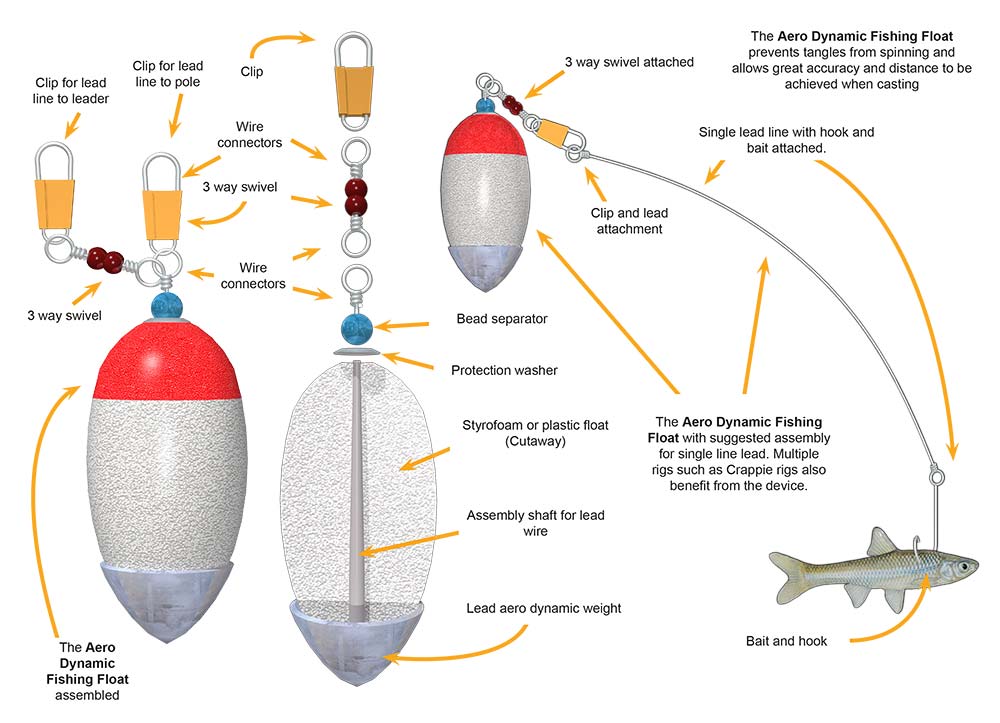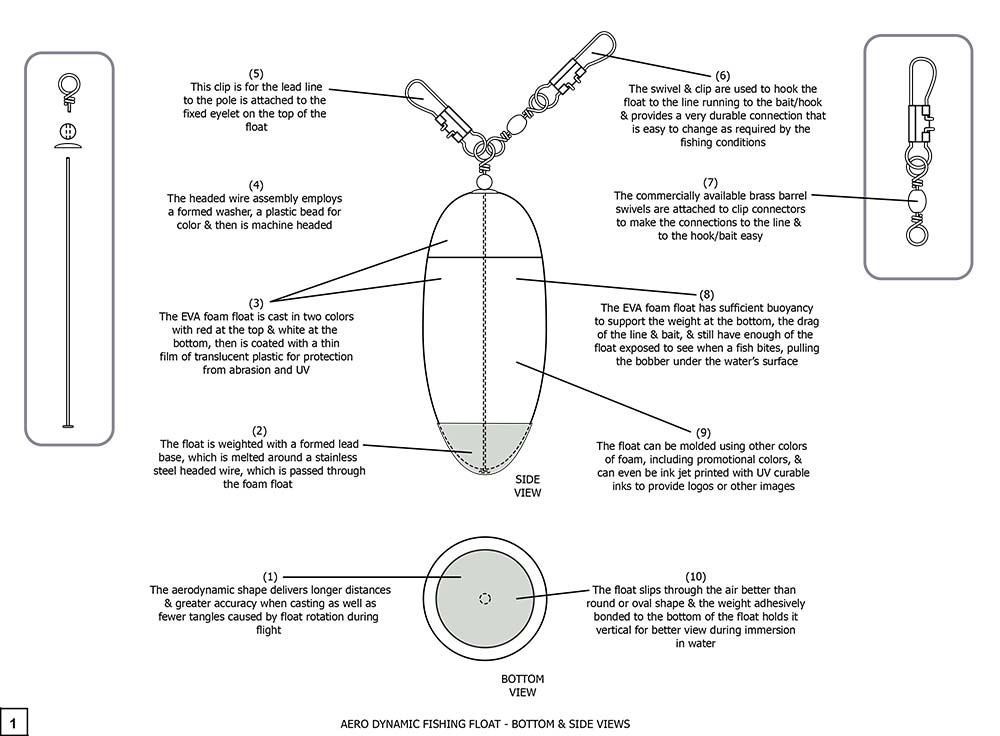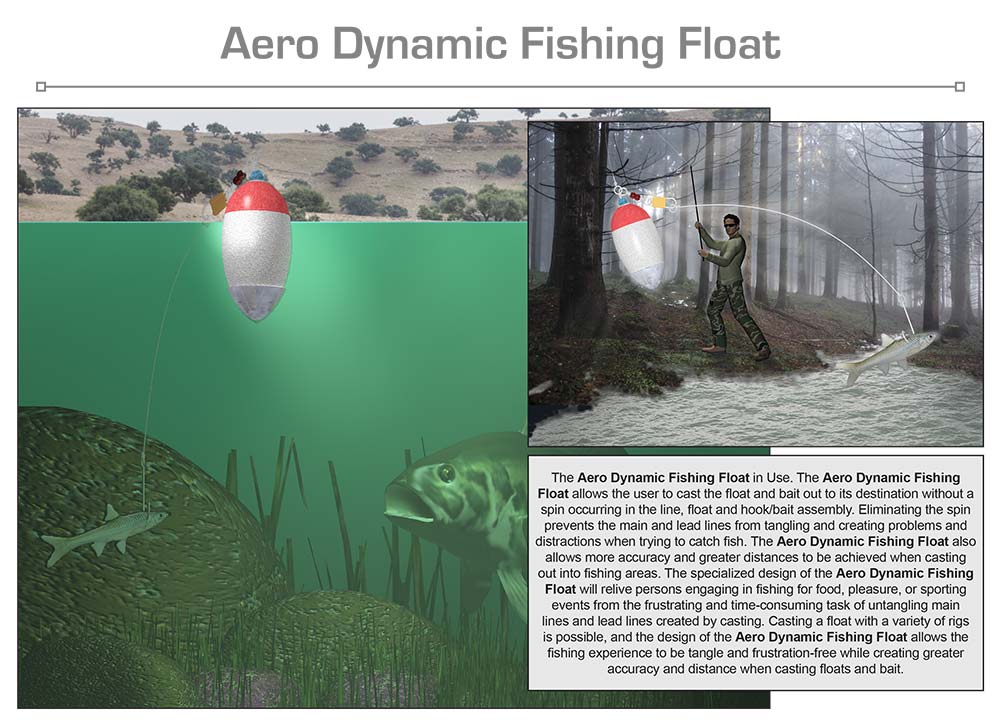
Aero Dynamic Fishing Float
DESCRIPTION:
Fishing has historically been a form of acquiring food for subsistence for individuals, families, and communities for thousands of years and probably as long as humans discovered that they could consume fish. Typically, fishing is a hunting process with most fish captured or caught in the wild and techniques include hand gathering, spearing, angling, netting, and trapping. The hunter-gather lifestyle of ancient peoples often resulted in a constant movement and migration out of necessity. Forced by nature to follow food sources many ancient peoples were nomads and very few permanent settlements were established. The few permanent settlements that did exist were almost exclusivity sustained by fishing and a fishing culture. The establishment of fishing communities was not necessarily permanently occupied as resources available could shift, and prime fishing areas could be fished out, or environmental changes could take place forcing relocations.
The introduction of boats would greatly aid in the development of semi-established communities to lasting ones from the resulting expansion of the range of fishing capacity. The ability of fishing to create a permanent settlement of humans is one of the first foundations of a sociological change that created the basis for modern civilization. The introduction of agriculture in addition to fishing is what fashioned the contemporary model of cities and townships that is recognized today.
Fishing in its many forms is still a significant cultural phenomenon and for many people has become a pastime and a sport rather than a system and source of subsistence. The most popular form of sport and past-time fishing is performed using the fishing rod and line. There are many variations of fishing reels that contain the fishing line, and the types of lures and baits used are almost endless in variety. The fishing rod although out of practicality is not as variable still has many different forms available for an individual who wants to take up fishing.
Utilizing the rod and reel to cast the bait or lure a significant distance allows the person to create a more substantial fishing zone around them that will enhance their chances of catching a fish at any given location. Fishing rigs with some arrangement of float and bait on them such as minnows or other systems of bait are particularly difficult to cast at any distance. The apparatus will tend to swivel uncontrollably causing tangles, inaccurate castings, and a reduction of the possible range of the cast. Tangles can prove to be very frustrating and reduces the enjoyment of what would generally be a pleasurable experience. The inaccurate casting can result in missing the desired landing location and the possibility the loss of the bait from the hook.
The Aero Dynamic Fishing Float presents an innovative and creative solution to tangles and inaccurate casting due to uncontrollable swiveling of floats and lead lines during casting of fishing floats, hooks, and bait. The Aero Dynamic Fishing Float consists of a specialized lead weight attached to an aero dynamic float constructed of Styrofoam or plastic. The lead weight has an internal shaft that is located in the vertical center of the float. At the top of the float is a flat washer to protect the float and create a frictionless surface between the surface of the float and the connected hardware. Attached to the top of the vertical shaft after the washer is a bead for spacing. The vertical shaft has a lead line that has a 3-way swivel attached to it. Above the 3-way swivel is located a brass and steel clip where a lead line is attached. The rig is available for multiple rigs such as Crappie rigs or other forms of fishing rigs. The Aero Dynamic Fishing Float will eliminate the uncontrolled swiveling of the lead line and fishing rig resulting in greater accuracy, longer casts, and the elimination of tangles.
SPECIFIC, UNIQUE FUNCTIONS OF INVENTION:
- Eliminates swiveling of lead lines during casting
- Increases accuracy of casting
- Eliminates tangles due to movement of leads during casting flight
- Increases distance of cast
- Easy and quick to attach and remove
- Can be used in conjunction with multiple rigs
- Rig is free to swivel when in the water and floating
- Works as a normal float when in water
- Helps prevent loss of bait when casting
PRODUCT COMPONENT CLARIFICATION:
The “Aero Dynamic Fishing Float” is an innovative fishing product that has been designed to present an aerodynamic cross section to the atmosphere providing greater distance when casting with a float and reduced line twists and tangles. The ‘stretched egg’ shape cuts through the air smoothly and is not as affected by wind as much as a round float so the accuracy is also enhanced. The foam body is much more resistant to knocks and dings than a Styrofoam product while the buoyancy is approximately the same. The barrel swivels allow the rig to rotate without tangling, and the clips make it easy to ‘rig’ and to tear down after fishing.
Currently, the fisherman typically uses round bobbers (floats) which are clipped onto the line a distance above the hook/bait and a weight is placed between the float and the hook/bait. Upon casting, the line tends to ‘whip’ around and because the float is not weighted, it tends to fly in the air and reduce the accuracy and length of the cast. Also, the bait/hook/weight tend to fly as well, resulting in tangles sometimes, which require retrieval, detangling, and recasting.
The “Aero Dynamic Fishing Float” resolve many of these problems by providing a streamlined shape with an integral weight at the bottom of the float. Also, the line to the rod/reel is isolated from the line going to the hook/bait allowing it to fly free and not tangle. The stainless-steel clips allow easy rigging before and teardown after fishing, while the swivels keep the line from wrapping and tangling.
The float: This float is molded from very low density, closed cell EVA (ethylene-vinyl acetate) foam. This foam is cast in 2 layers in a permanent mold, with the red dyed material near the top of the mold and white dyed material running from the red down to the bottom of the mold. After curing, the float is removed from the mold and dip coated with a thin layer of UV resistant, translucent polymer vinyl coating, which is then thermally cured. The wire with the eyelet and bead is thrust through the cupped washer, through the float, and into the adhesively bonded cast lead weight on the bottom of the float. It is wound to tighten it against the bottom of the lead weight and then the lead is touched with a very high temperature flame and flowed around the wire, while carefully controlling the rest of the weight’s temperature so it doesn’t melt the EVA foam or degrade the adhesive bond.
The swivels and clips: These commercially available brass barreled swivels are supplied with eyelets formed and terminated in the barrels. The eyelet on one end of the swivel is cut, slid over the eyelet in the top of the float, compressed, and spot welded to make it a solid loop again. Then two commercially available stainless-steel clips are attached, one the float eyelet and one to the swivel eyelet. The float is now complete and ready to be packaged for the point-of-sale rack.
The Aero Dynamic Fishing Float is designed to be aesthetic and effective in the application. The relative ease of manufacture and the moderately inexpensive components provide good marketability for the manufacturer. The user benefits from improved flight distance and accuracy with fewer tangles and a better delivery of the hook/bait to the optimum fishing spot, which should provide considerable market interest in the product.
The invention is illustrated in the following drawings of the essential points as explained to us in the documentation.

Drawing 1, Block 1: Aero Dynamic Fishing Float – Bottom And Side Views
(1) The aerodynamic shape delivers longer distances and greater accuracy when casting as fewer tangles cause by float rotation during flight.
(2) The float is weighted with a formed lead base, which is melted around a stainless steel headed wire, which is passed through the foam float. This captures the foam float securely with the cupped washer at the top and the adhesively bonded lead weight at the bottom.
(3) The EVA foam float is cast in two colors with the red at the top and the white at the bottom, and then is coated with a thin film of translucent plastic for protection from abrasion and UV.
(4) The headed wire assembly employs a formed washer, a plastic bead for color, and then is machine headed.
(5) This clip is for the lead line to the pole is attached fixed eyelet on the top of the float.
a. As an option, this arrangement could also include a barrel swivel.
(6) The swivel and clip are used to hook the float to the line running to the bait/hook and provides a very durable connection that is easy to change as required by the fishing conditions.
(7) The commercially available brass barrel swivels are attached to the clip connectors to make the connections to the line and to the hook /bait easy.
(8) The EVA foam float has sufficient buoyance to support the weight at the bottom, the drag of the line and bait, and still have enough of the float exposed to see when a fish bites, pulling the bobber under the water.
(9) The float can be molded using other colors of foam, including promotional colors, and can even be ink jet printed with UV curable inks to provide logos or other images.
(10) The float slips through the air better than round or oval shapes and the weight adhesively bonded to the bottom of the float holds it vertical for better view during immersion in water.
Although a single embodiment of the invention has been illustrated in the accompanying drawings and described in the above detailed description, it will be understood that the invention is not limited to the embodiment developed herein, but is capable of numerous rearrangements, modifications, substitutions of parts and elements without departing from the spirit and scope of the invention.
This document has been prepared for the manufacturer’s elucidation. The manufacturer’s decision makers should consider this product for licensing (providing intellectual property protection for their sales of the product in return for a royalty payment for a period of years) or an outright purchase of the patent for a negotiated fee. The inventor and his team are standing by to consider offers for licensing or outright purchase of the patent.


